Speaker Bio: Secure More Speaking Gigs (6 Examples)

Has anyone ever asked you to talk about yourself, and you thought, “Where do I even begin?”
As a speaker, talking about yourself and your experiences may not seem like a hard task because it’s just what you do! You give awe-inspiring speeches for a living.
But in order to convince people to book you for events, you can’t always flash your best presentation and speech in front of a client. People don’t have time for that.
You need a speaker bio to do the talking for you. And you really need to make sure it’s saying the right stuff.
We’re going to guide you through writing a compelling speaker bio that will help you put your best foot forward and get more speaking opportunities.
Plus, we have 6 examples to show you how it’s done!
What is a Speaker Bio?
A speaker bio is a quick introduction of yourself and your accomplishments in your field. It tells the client and possible attendees who you are and why you’re worth listening to.
But it’s also a chance for you to humbly brag about yourself and show off your personality. It persuades clients to book you for speaking engagements and it gets people in seats.
Why You Need A Mind-Blowing Speaker Bio
You may think that listing your accolades and your expertise is enough to wow a client, but unless you’re a well-known speaker offering your services for free, no client will book you on the spot.
Your bio will be in front of the eyes of an event planner who must consider their budgeting constraints, the needs of the attendees, and whether you’ll add value for them.
You have a small window of opportunity, and your speaker bio will allow you to grab their attention.
And if you get booked, the planner will share your bio with the potential audience for them to decide whether they want to spend their time listening to you versus other speakers.
Lastly, a good speaker bio will persuade more people to attend. And the more people attend your talk, the better.
Who knows, a few attendees might turn into long-term clients.
How To Write A Speaker Bio
Talking about yourself should be a piece of cake, but writing about yourself? Not as easy, especially if you have a limited word count.
Writing your speaker bio may feel cringeworthy because you have to talk yourself up, but if you follow the below tips and steps, it’ll be way more manageable.
- Make a list
- Research your audience
- To third person or not to third person
- Size matters
- Make variations
- Pick your accomplishments carefully
- Published work
- Speaking experience
- Testimonials
- The value you add
- Add a pinch of personal touch
- Your voice
- Editing makes perfect
- One last piece of advice
1. Make a list
Take out your CV and all your past certificates and start listing it all in a document. That means all your experience, accomplishments, awards, qualifications, published works, and interests.
If you won a hot dog eating contest years ago, go ahead and list that too! This is not the step to be picky.
This will help you get an overview of what you’ve done in your life that could be intriguing to clients.
Anything and everything that could potentially be of use should be noted because you’ll make many speaker bios, so you need to keep the information fresh and engaging for each variation.
2. Research your audience
The next important thing to do is research your target audience. If you’re not sure who you’re sending this bio to yet, you can start off with a general picture of who you think your audience is.
What are their interests, needs, and wants? Demographics like age, profession, and location can help you form a clearer picture of them.
This will help you understand what will pique their interest, therefore helping you decide what to add from your list and what tone to write it in.
For example, if your audience is primarily marketing folk, they may appreciate more conversational language and interesting facts like the increased email open rates you’ve achieved in the past year.
If you have a client in mind for your speaker biography, then you have to research their audience’s needs and how to position yourself as someone who can add value for them.
3. To third person or not to third person
Usually when it comes to author bios or bios that go below a book blurb, writing in third person is the format most people use.
It comes off as professional and it’s the standard of the industry.
But when it comes to your speaker bio, you can break the rules. It just depends on what you aim to do with your bio.
For example, for a business executives crowd, third person may come off as more professional and appealing. While for the social media crowd, first person with a friendly tone may engage the audience more.
There’s no hard and fast rule. Even some speaker websites don’t write their About page information in third person. Because using first person can give off that extra personal touch.
But on the other hand, third person can be easier to write in as it doesn’t sound as braggy.
Because:
‘Speaker Name is the #1 New York Times bestselling author of a critically acclaimed book.‘
sounds better than:
‘I am the #1 New York Times bestselling author of a critically acclaimed book.‘
The first statement sounds more natural, while the second statement may make the reader want to roll their eyes and say, “Okay show off.”
4. Size matters
A speaker bio is not a one-size-fits-all sort of deal. And however long it is, your bio needs to be easy to skim through and still get the gist of it.
Follow the below guide to decide on the length:
- Proof of expertise: For a speaker bio that’s bare bones (qualifications, experience, and the benefits of your speech) go for 75-100 words.
- Succinct intro: If you want a bio with just the highlights, for example on social media profiles, go for 50 words maximum.
- Complete package: If you have space to flaunt it all, go for 250 words maximum.
- Life story: If you want to go into more detail and showcase the whole shebang, for example on your speaker website, you can do 300+ words (just be careful not to ramble and keep it engaging and relevant).
5. Make variations
Don’t ever delete or edit your original speaker bio. You may need that specific one again someday.
You need more than one variation to suit different events and audiences, so be sure to keep a backlog of all the ones you’ve used and what their main purpose was.
Having many speaker bios will allow you to virtually introduce yourself to potential clients and audience members on different platforms like social media, your speaker website, and as a guest speaker at conferences.
6. Pick your accomplishments carefully
Hand-picking your accomplishments, expertise, and qualifications to suit the audience is about communicating the right message to them.
A relevant degree shows your training in the field, awards show your excellence, and your occupation position shows credibility and authority.
You want to curate a bio that has the audience wanting to know more.
You want them to also relate to you and trust you before you get up on stage.
7. Published work
If you’ve written a book, or have done other work in your field of expertise, make sure to mention it in your speaker bio as it will solidify your expertise.
And this will give the audience a chance to look you up and find this information, giving you more exposure on those platforms.
8. Speaking experience
Listing the appropriate past speaking engagements can be vital.
It shows that, besides your authority in your field, you can speak well on it too – so much so that many other venues have booked you.
This will aid you in gaining the trust of the person reading your speaker bio. Because they don’t just want an expert; they want someone who knows their way around a mic.
9. Testimonials
What’s better than you saying that you’re great? When someone else says it too.
Professional Reviews and Testimonials are an undeniably important way to persuade someone to believe what they’re reading to be true.
Adding in a testimonial from one of your previous talks will prove to potential clients that you can deliver.
Top Tip 1: Remember to only add a testimonial that says something, it must not be a bland quote. It needs to expand on what you’ve already mentioned in your speaker bio or highlight an important part that should stick in audiences’ minds.
10. The value you add
Make it clear as day who your talk will benefit and how it will benefit them.
This way, you’re grabbing the attention of your target audience. Otherwise, you could be engaging the not-so-ideal target audience who will be skeptical of your talk and might leave a not-so-nice review later.
Top Tip 2: Highlight your unique perspective in your speaker bio. This will help you stand out from others in your field, showing what value the audience may gain from attending.
11. Add a pinch of personal touch
You’re done selling them on how great you are, now you have to show them your human side.
We human beings gravitate towards what has that humanized factor. It’s proven that when there’s a human element, we’re more likely to pay attention.
End off your speaker bio with 1-2 sentences about yourself. This could be some fun facts, for example, your interests and hobbies, or that you won a hotdog eating contest (see we told you this may come in handy).
This will make you more memorable and will show that you’re not a robot rattling off accomplishments.
12. Your voice
Your speaker bio should be an extension of you or at least a brief view of the highlights. So, it needs to sound like you.
This seems obvious, but the essence of how you’ll deliver your speech needs to be present in your speaker bio. This will entice the audience to attend your talk.
Now, you don’t have to write everything with your wonderful flare, because it still needs to be easy to read. But the person reading the bio should feel intrigued enough to attend.
13. Editing makes it perfect
The first iteration will never be perfect, you have to review and edit before you’ll be happy with your speaker bio.
When editing, besides ensuring the speaker bio targets the right audience, you have to check for typos and grammatical errors. You don’t want to look unprofessional to clients.
Proofread your bio a few times, then hand it over to a friend or colleague to give it the final okay.
14. One last piece of advice
If you’re still struggling to start your speaker bio, we have one last tip for you.
Consider why you do what you do and the passion behind it all. This will guide you to writing an authentic speaker bio that resonates with your audience because they’ll feel the emotion in the words.
So, think of your speaker bio as a way of telling your story.
How To Write A Bio For A Conference
Conferences are a great way for speakers to strut their stuff. It’s what conferences are made for!
But to get yourself to speak at one, or to ensure people attend…you’ve guessed it.
Your speaker bio needs to be good.
Follow the below steps to elevate your speaker bio for conferences:
- Tailor to the theme
- Use the right format
- Hook them from the jump
- End with a big finish
1. Tailor to the theme
We’ve already spoken about catering to your audience, but now you have to consider the themes of the conference.
The audience of the conference and your target audience may overlap, but that doesn’t mean you should phone it in with your basic speaker bio.
The event planner might find you impressive, but once you get booked, your bio will sit beside many others, and the audience has to pick between you and plenty more.
Put in the extra effort and customize your speaker bio to the conference. This means using a different tone, restructuring and rearranging information, and putting in suitable information according to the conference.
This extra work will inadvertently show the audience that you care.
Top Tip 3: You can throw in some details on what the audience can expect from your talk, sweetening the deal for anyone on the fence about joining your session.
2. Use the right format
Some organizations will feel relieved that you’ve written a good speaker bio for them to promote. That’s one less thing for them to worry about when marketing the conference.
However, some organizations have requirements for the speaker bio format and how long it is. Make sure to follow this so you don’t give the organizers more work in editing yours, or worse your speaker bio gets tossed out.
3. Hook them From The Jump
This can be applied to all variations of your speaker bio: start with a bang.
Your first statement should hook the person reading it, encouraging them to read till the end.
Your first sentence should be daring and thought-provoking. The reader should be captivated by this statement.
4. End with a big finish
Besides the addition of the personal anecdote that we discussed above, you should end your speaker bio with a sort of guarantee that the audience will come out with a benefit, or at least with more knowledge than they had before.
Top Tip 4: A neat little addition to the end of your speaker bio can be a call to action (CTA). A CTA is used to instruct readers on what they should do next. In the case of a speaker bio, it can be, “I can’t wait to share my newly found insights with you all.”
6 Captivating Speaker Bio Examples
We’ve listed 6 speaker bio examples so you can analyze what’s successful about them
Here are the 6 examples of speaker bios:
Amy Blankson: Opening Line

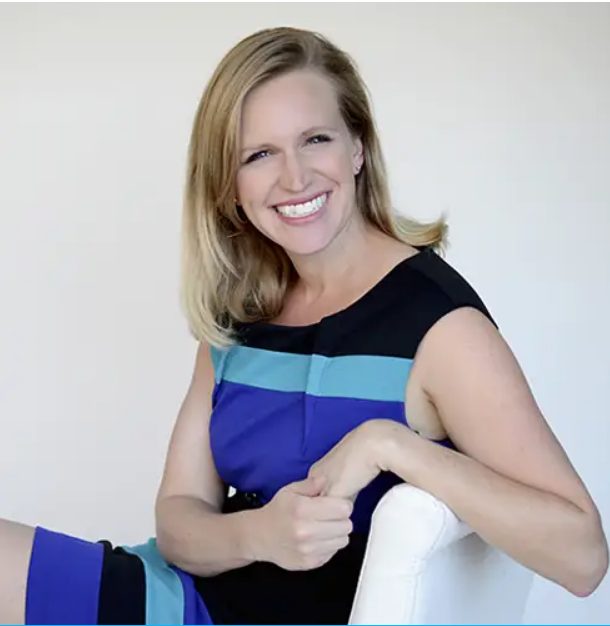
Amy Blankson is the only person to be named a Point of Light by two Presidents (President Bush and President Clinton). She received a Presidential appointment to serve a five-year term on the Board of Directors of the Corporation for National Service, and was one of the youngest delegates to the Presidents’ Summit for America’s Future. Amy received her BA from Harvard and MBA from Yale School of Management. She went on to co-found the Future of Philanthropy Conference at Yale University, and in 2007, joined GoodThink on the ground floor to develop and scale the company as it sought to bring the science of happiness to life.
Drawing on over 17 years of management and consulting experience with businesses, foundations, and nonprofits, Amy Blankson brings both passion and practicality to GoodThink. She is currently doing research in partnership with Google to determine how to make positive psychology strategies stick and create sustainable positive change. Amy is the author of the award-winning children’s book Ripple’s Effect, and has three beautiful daughters who teach her about the joy of positivity and the importance of gratitude on a daily basis.
Why it works
Amy Blankson’s speaker bio is all about credibility and expertise.
We get the background as to how she got where she is now, plus a peak into what she’s currently working on with a pretty impressive company (that’s right, Google).
But what we love most is how the speaker bio starts off with a wowza of a testimonial from not one, but two presidents. This immediately pops and encourages the reader to keep reading to find out why two presidents feel this way.
Brené Brown: Bullet Points
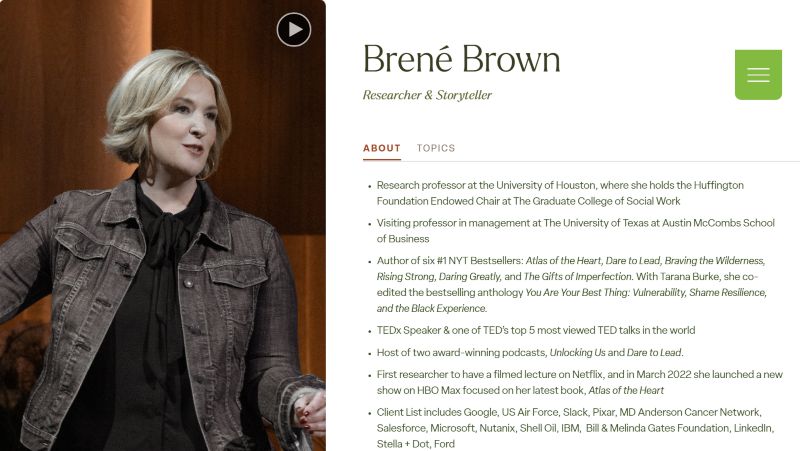
– Research professor at the University of Houston, where she holds the Huffington Foundation Endowed Chair at The Graduate College of Social Work
– Visiting professor in management at The University of Texas at Austin McCombs School of Business
– Author of six #1 NYT Bestsellers: Atlas of the Heart, Dare to Lead, Braving the Wilderness, Rising Strong, Daring Greatly, and The Gifts of Imperfection. With Tarana Burke, she co-edited the bestselling anthology You Are Your Best Thing: Vulnerability, Shame Resilience, and the Black Experience.
– TEDx Speaker & one of TED’s top 5 most viewed TED talks in the world
– Host of two award-winning podcasts, Unlocking Us and Dare to Lead.
– First researcher to have a filmed lecture on Netflix, and in March 2022 she launched a new show on HBO Max focused on her latest book, Atlas of the Heart.
– Client List includes Google, US Air Force, Slack, Pixar, MD Anderson Cancer Network, Salesforce, Microsoft, Nutanix, Shell Oil, IBM, Bill & Melinda Gates Foundation, LinkedIn, Stella + Dot, Ford
Why it works
Brené Brown’s speaker bio is straight to the point – bullet point to be exact.
This simple way of jotting down your achievements works well for her because her reputation will likely proceed her for those in her field.
Even though it’s listed in point form, it still tells a story. We move from her expertise and qualifications to her published books, and speaking experience (TED talks, no big deal). Lastly, we see more of her escapades and her list of impressive clients.
As we move down the list we get more and more intrigued by what Brené has achieved.
Chad Mathew: First Person
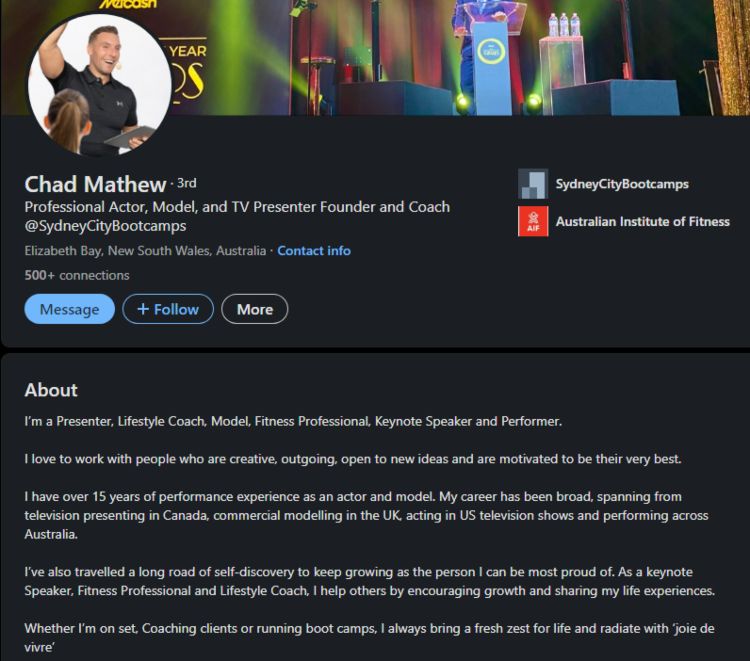
I’m a Presenter, Lifestyle Coach, Model, Fitness Professional, Keynote Speaker and Performer.
I love to work with people who are creative, outgoing, open to new ideas and are motivated to be their very best.
I have over 15 years of performance experience as an actor and model. My career has been broad, spanning from television presenting in Canada, commercial modelling in the UK, acting in US television shows and performing across Australia.
I’ve also travelled a long road of self-discovery to keep growing as the person I can be most proud of. As a keynote Speaker, Fitness Professional and Lifestyle Coach, I help others by encouraging growth and sharing my life experiences.
Whether I’m on set, Coaching clients or running boot camps, I always bring a fresh zest for life and radiate with ‘joie de vivre.’
Why it works
Chad lets the reader know that he’s a jack of all trades with this speaker bio example from LinkedIn.
And because it’s written in first person, it has a very authentic nature about it. It feels like he’s talking directly to the reader.
We love this bio because even with his many ventures, he manages to provide credibility for each.
This allows anyone who finds his LinkedIn to pick out what is most important to them.
Simon Bailey: Personal Touch
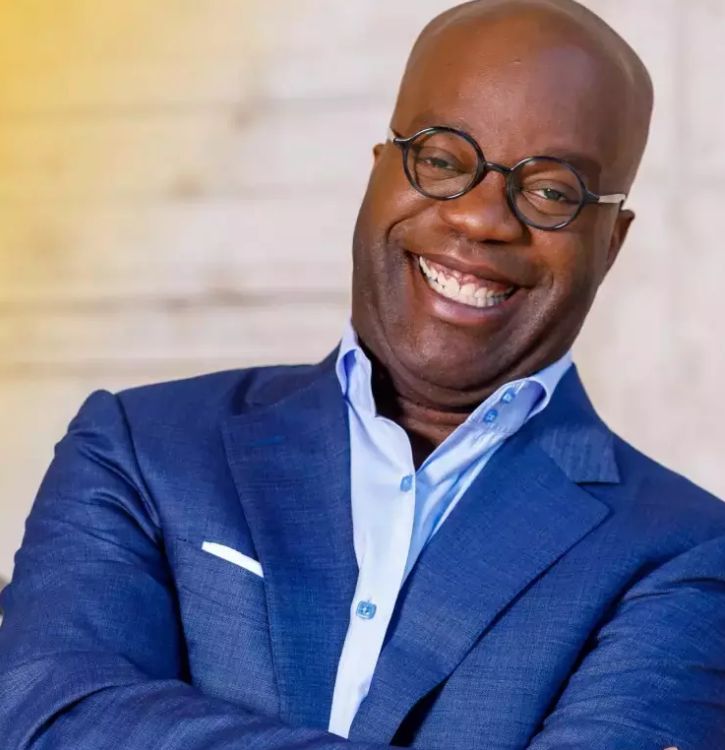
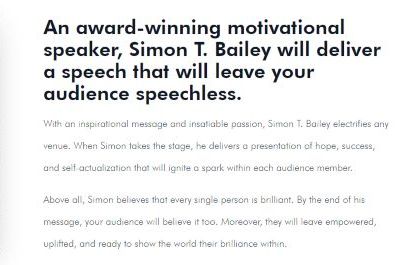
An award-winning motivational speaker, Simon T. Bailey will deliver a speech that will leave your audience speechless.
With an inspirational message and insatiable passion, Simon T. Bailey electrifies any venue. When Simon takes the stage, he delivers a presentation of hope, success, and self-actualization that will ignite a spark within each audience member.
Above all, Simon believes that every single person is brilliant. By the end of his message, your audience will believe it too. Moreover, they will leave empowered, uplifted, and ready to show the world their brilliance within.
Why it works
Simon’s speaker bio oozes with passion. It begins with accolades, which builds trust with the audience. This allows the rest of the bio to talk more earnestly, trying to evoke emotions from the reader.
This is what we love about his speaker bio! It has a more personal touch but you somehow know you can rely on Simon to deliver one heck of a speech.
Chunka Mui: Longer Text
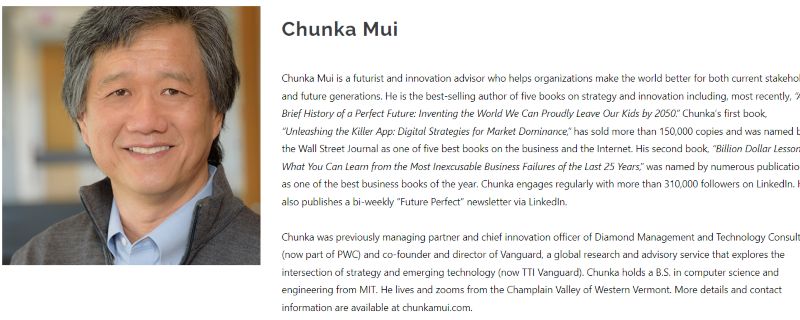
Chunka Mui is a futurist and innovation advisor who helps organizations make the world better for both current stakeholders and future generations. He is the best-selling author of five books on strategy and innovation including, most recently, “A Brief History of a Perfect Future: Inventing the World We Can Proudly Leave Our Kids by 2050.” Chunka’s first book, “Unleashing the Killer App: Digital Strategies for Market Dominance,” has sold more than 150,000 copies and was named by the Wall Street Journal as one of five best books on the business and the Internet. His second book, “Billion Dollar Lessons: What You Can Learn from the Most Inexcusable Business Failures of the Last 25 Years,” was named by numerous publications as one of the best business books of the year. Chunka engages regularly with more than 310,000 followers on LinkedIn. He also publishes a bi-weekly “Future Perfect” newsletter via LinkedIn.
Chunka was previously managing partner and chief innovation officer of Diamond Management and Technology Consultants (now part of PWC) and co-founder and director of Vanguard, a global research and advisory service that explores the intersection of strategy and emerging technology (now TTI Vanguard). Chunka holds a B.S. in computer science and engineering from MIT. He lives and zooms from the Champlain Valley of Western Vermont. More details and contact information are available at chunkamui.com.
Why it works
Chunka’s speaker bio is professional just as you’d expect a good bio to be, but it uses its lengthy text in a very wise way. It begins by telling us what Chunka does now, and then as you read on you learn why he’s equipped to do it.
The first half of the bio goes into detail on how well-received his books are, giving testimonials. This bolsters Chunka’s credibility as anyone who reads this will trust his expertise in this field a whole lot more.
The second half digs into his experience and qualifications to seal the deal.”
A nice call to action caps it off, giving the reader their next task: to find out more.
Iyanla Vanzant: Relatable

From welfare mother to New York Times best-selling author, from the Brooklyn projects to Emmy Award winner, from broken pieces to peace, Iyanla Vanzant is one of the country’s most celebrated writers and public speakers, and she’s among the most influential, socially engaged, and acclaimed spiritual life coaches of our time.
Why it works
When you want to reach your target audience, you should be as relatable as possible. Iyanla does this well by showing how her upbringing relates to her line of work.
The speaker bio uses contrast to do this. We see Iyanla before and after her accomplishments to show how far she’s come and why she’s someone her target audience should listen to.
Then you add in the social proof and credibility to create a bio that engages the reader from the get-go right up until the last word.
Speaker Bio Template
There’s no basic template that you can just fill in, sadly. But we’ve still got you covered with a guide.
If you need an extra push to get started, here’s a bio template any speaker can use:
- Credibility: Show the speaker’s qualifications, accomplishments, experience, accolades, etc.
- Social Proof (if none, leave out): Use Endorsements that solidify the speaker’s credibility.
- Other Works: Include other works like published books, podcasts, TV shows, or any other ventures the target audience would find interesting.
- Personal Touch: 1-2 lines of personal information that humanizes the speaker bio – only add what you are comfortable with.
- Value Add and Call To Action: Show the benefits attendees can reap from hearing your speech and include a call to action (CTA) with links to social media profiles, newsletters, etc.
How To Keep Speaking
A speaker bio is excellent at being that digital handshake between you and a potential client – but it doesn’t guarantee you more speaking engagements.
You have to keep putting yourself out there and making sure your target audience never forgets about you.
The best way to do this is by having a concrete online presence. Because anyone looking for speakers like you should find YOU.
We suggest starting with a speaker website. A quick Google search for your name and your target audience will have all the information they’ll ever need about you in one central location.
We love creating online platforms for speakers that help them soar to new heights, so fill in this inquiry form and we’ll see how we can help your dreams come true.
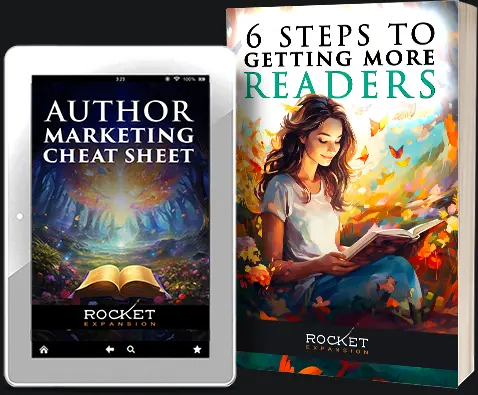
Want help with your author marketing? Get our FREE ebook and cheat sheet: 6 Steps To Getting More Readers.
By subscribing, you agree to get emails from me, Matt Ziranek. I’ll respect your privacy and you can unsubscribe any time.
